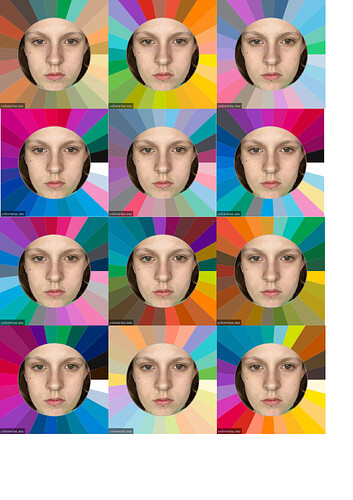I cant figure it out help!
I realise this is an old post - so I hope in fact the matter has been sorted out to your satisfaction!
But if not, or in case it is useful to someone else, the conclusions I have come to after playing with this tool are:
- It’s practically impossible to see someone’s colour season by surrounding their face with all the colours at once, because of the way the colours then react to each other. There are very few circumstances in which anyone would wear that many colours in about equal proportions! Professionals may be able to judge from the whole palate at once due to their levels of experience, but I don’t think it is the best way to start.
- If you go into the palates from the welcome page and scroll down to the large block of colour that shows at the bottom, and click on the eye icon in the right hand corner (on laptop) it is possible to get it to show your photo with only one colour. (It is then possible to play with the sliders or click on the other colours showing in the palate to change that colour). In general, I think the advice is to start by comparing an orange and a fuchsia (so, a purple pink), to see if the skin undertone is warm or cool. Though people usually use the dark and bright versions of the colours for this, I am convinced that with lighter skin it is actually easier to see if you set the colour fairly pale (80-90). (This MAY be true for everyone but I do not have a range of people to experiment on). As many people can borrow quite a few colours from neighbouring subseasons, I have been quite frustrated when trying to find the best colours to compare for checking the subseasons: it may depend on the interpretation of the palate. However, in general, comparing the warmest colours of warm autumn or warm spring, with the softest colours of soft autumn and the lightest colours of light spring, is likely to work (if you are a warm autumn, in theory, it should be the warmest colours of soft autumn that also work well). It is worth putting in a few which should be wrong by your first judgement, both to check it, and to help keep your eye in with regard to what you are looking at. If stuck, imagining how you would look in a full dress or suit of the relevant colour often helps.
- It’s necessary to be careful about drawing firm conclusions from only one data point. Colour is complicated and there are a lot of little retrograde quirks in what actually works. For example, clear springs can often pull off black because they have such high contrast, and clear winters often in fact look better in light cream than in optic white or grey, because of their high saturation. Going on that data point alone, the bright spring would conclude they were a winter, and the bright winter would conclude they were a spring or autumn.
- It matters to be careful to choose photos that show real colouring, if you cannot use drapes and a mirror. I experimented extensively with two particular photos, both taken in natural light, one of which definitely shows me as cool and the other of which definitely shows me as warm. As far as I can make out in real life, I am probably cool-neutral. The photos that show me warm were mostly taken against a pure white background, so it may be as simple as that. (If anyone who knows more about photography has anything to add to this, that would be amazing!).
- It is often possible to tell more from what looks bad than what looks good. If you can identify your “death warmed up” colour, that is likely to help eliminate a lot of seasons.
- The colour model is a model and it has limitations, particularly for those who are less strongly one type. I seem to have eyes that are significantly warmer than my skin in colour, and it is hard to see if dark or clear is more dominant in my appearance. This is probably not unusual.
Anyway, hope someone finds this helpful ![]() and really would appreciate anyone chipping in who can fill in any of the gaps in my knowledge/speculations
and really would appreciate anyone chipping in who can fill in any of the gaps in my knowledge/speculations ![]()
1 Like

